大学英语教学法整理
大学生英语教学法教案
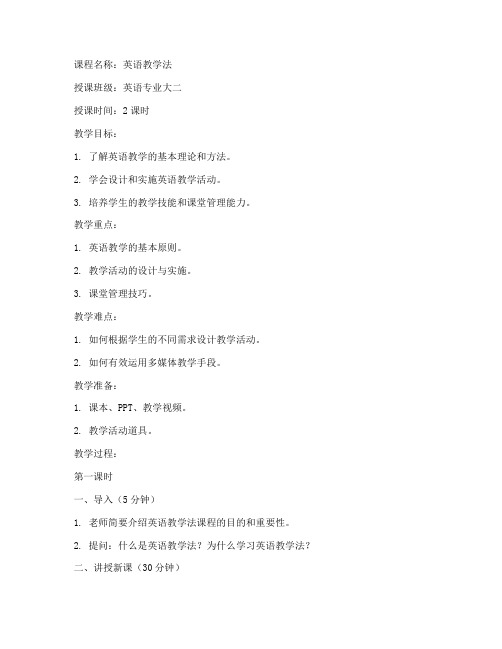
课程名称:英语教学法授课班级:英语专业大二授课时间:2课时教学目标:1. 了解英语教学的基本理论和方法。
2. 学会设计和实施英语教学活动。
3. 培养学生的教学技能和课堂管理能力。
教学重点:1. 英语教学的基本原则。
2. 教学活动的设计与实施。
3. 课堂管理技巧。
教学难点:1. 如何根据学生的不同需求设计教学活动。
2. 如何有效运用多媒体教学手段。
教学准备:1. 课本、PPT、教学视频。
2. 教学活动道具。
教学过程:第一课时一、导入(5分钟)1. 老师简要介绍英语教学法课程的目的和重要性。
2. 提问:什么是英语教学法?为什么学习英语教学法?二、讲授新课(30分钟)1. 英语教学的基本原则:- 学生为中心的教学原则- 目标导向的教学原则- 互动性原则- 多元化原则2. 教学活动的设计与实施:- 设计教学活动的基本步骤- 案例分析:分析一个教学活动的成功之处和不足之处三、课堂练习(15分钟)1. 学生分组讨论,设计一个简单的英语教学活动。
2. 每组选派代表进行展示,其他同学进行评价。
四、总结与作业(5分钟)1. 老师总结本节课的重点内容。
2. 布置作业:阅读教材相关章节,准备下一节课的讨论。
第二课时一、复习与提问(5分钟)1. 老师提问上节课的重点内容。
2. 学生回答问题。
二、讲授新课(30分钟)1. 课堂管理技巧:- 建立良好的课堂纪律- 激发学生的学习兴趣- 处理课堂突发事件2. 多媒体教学手段的应用:- PPT教学- 视频教学- 网络教学资源三、课堂练习(15分钟)1. 学生分组讨论,设计一个包含多媒体教学手段的英语教学活动。
2. 每组选派代表进行展示,其他同学进行评价。
四、总结与作业(5分钟)1. 老师总结本节课的重点内容。
2. 布置作业:结合所学内容,设计一个完整的英语教学方案。
教学反思:本节课通过讲解、案例分析、课堂练习等形式,使学生对英语教学法的基本理论和方法有了初步的认识。
在教学过程中,注重培养学生的教学技能和课堂管理能力。
英语教学方法范文
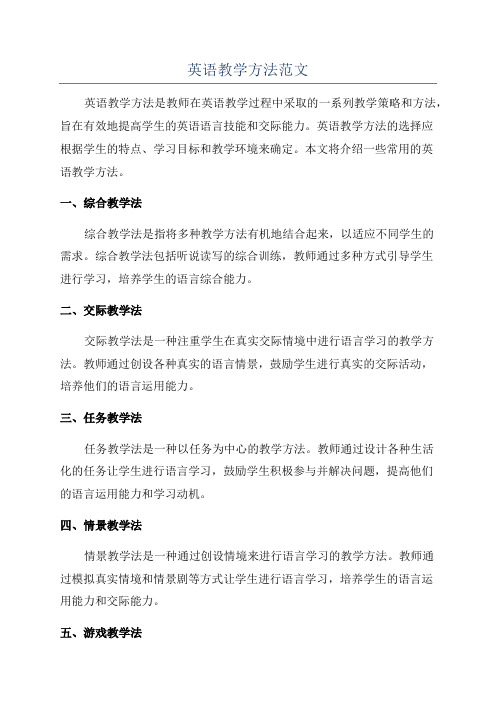
英语教学方法范文英语教学方法是教师在英语教学过程中采取的一系列教学策略和方法,旨在有效地提高学生的英语语言技能和交际能力。
英语教学方法的选择应根据学生的特点、学习目标和教学环境来确定。
本文将介绍一些常用的英语教学方法。
一、综合教学法综合教学法是指将多种教学方法有机地结合起来,以适应不同学生的需求。
综合教学法包括听说读写的综合训练,教师通过多种方式引导学生进行学习,培养学生的语言综合能力。
二、交际教学法交际教学法是一种注重学生在真实交际情境中进行语言学习的教学方法。
教师通过创设各种真实的语言情景,鼓励学生进行真实的交际活动,培养他们的语言运用能力。
三、任务教学法任务教学法是一种以任务为中心的教学方法。
教师通过设计各种生活化的任务让学生进行语言学习,鼓励学生积极参与并解决问题,提高他们的语言运用能力和学习动机。
四、情景教学法情景教学法是一种通过创设情境来进行语言学习的教学方法。
教师通过模拟真实情境和情景剧等方式让学生进行语言学习,培养学生的语言运用能力和交际能力。
五、游戏教学法游戏教学法是一种通过游戏方式进行语言学习的教学方法。
教师可以设计各种有趣的游戏,让学生在游戏中进行语言交流和学习,增加学习的趣味性和积极性。
六、多媒体教学法多媒体教学法是一种利用多媒体技术进行语言教学的方法。
教师通过使用多媒体软件、音视频等教学资源,使语言学习更加直观、形象,提高学生的学习兴趣和效果。
七、个别化教学法个别化教学法是一种根据学生的特点和需求进行个别化教学的方法。
教师通过了解学生的学习情况和需求,为每个学生制定个别的学习计划和教学方案,提高教学的针对性和效果。
八、合作教学法合作教学法是一种通过学生之间的合作来进行语言学习的方法。
教师可以组织学生进行小组活动、角色扮演等形式的合作学习,培养学生的团队合作精神和语言交际能力。
九、自主学习法自主学习法是一种注重学生自主学习和探究的教学方法。
教师在课堂上起到指导和引导的作用,让学生根据自己的学习节奏和风格进行学习,培养学生的学习能力和自我管理能力。
大学英语教学方法总结
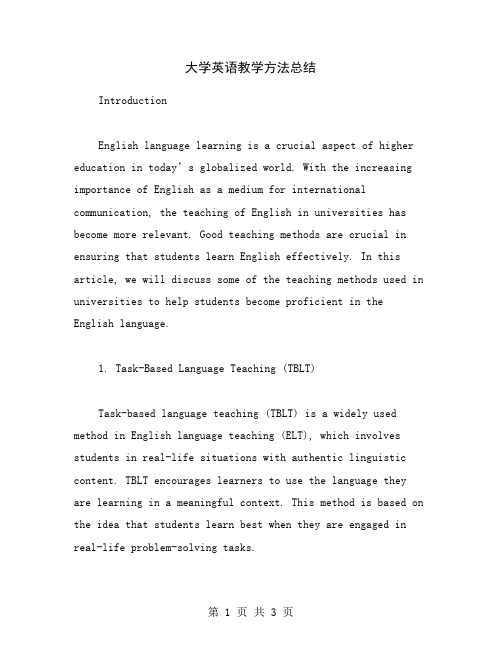
大学英语教学方法总结IntroductionEnglish language learning is a crucial aspect of higher education in today’s globalized world. With the increasing importance of English as a medium for international communication, the teaching of English in universities has become more relevant. Good teaching methods are crucial in ensuring that students learn English effectively. In this article, we will discuss some of the teaching methods used in universities to help students become proficient in the English language.1. Task-Based Language Teaching (TBLT)Task-based language teaching (TBLT) is a widely used method in English language teaching (ELT), which involves students in real-life situations with authentic linguistic content. TBLT encourages learners to use the language they are learning in a meaningful context. This method is based on the idea that students learn best when they are engaged in real-life problem-solving tasks.2. Communicative Language Teaching (CLT)Communicative Language Teaching (CLT) is another widely used method in ELT, which emphasizes the importance of communication and aims to develop learners’ communicative competence through interaction with others. In CLT, language is taught in context, and learners are encouraged to use the language for communicative purposes. This approach promotes learner-centered teaching, where the focus is on the learner’s needs and interests.3. Content-Based Instruction (CBI)Content-based instruction (CBI) is a language teaching approach that combines language learning with the learning of academic content. In this method, students learn the language through the content they are studying. CBI is particularly effective in teaching English for specific purposes (ESP), such as business, law, medicine, or engineering, where students need to communicate effectively in their field of study.4. Grammar Translation Method (GTM)The Grammar Translation Method (GTM) is a traditional approach to language teaching that involves the teaching of grammar and vocabulary through translation exercises. This method has been widely criticized for not promoting communicative competence. However, GTM is still used in some universities to teach written language skills.ConclusionEnglish language teaching methods have evolved over time, w ith more emphasis on communication and learners’ needs.Task-Based Language Teaching, Communicative Language Teaching, and Content-based Instruction are some of the methods that have been widely used in universities to teach English effectively. While traditional methods such as the Grammar Translation Method are less effective, they are still used in some universities. English language teachers today need to be aware of the effectiveness of different methods to ensurethat they are using the latest teaching techniques to helptheir students learn the language effectively.。
大学----英语教学法

Hymes’s theory: there are “rules of use without which the rules of grammar would be useless”. Besides grammatical rules, language use is governed by rules of use, which ensure that the desired or intended functions are performed and the language used is appropriate to the context.
We can see that one language form may express a number of communicative functions and one communicative function can also be expressed by a variety of language forms.
Aims of the unit: How is language learned in classrooms different from
language used in real life? What is communicative competence? What are the implications of CLT to teaching and learning? What are the main features What is Task-based Language Teaching? How is Task-based Language Teaching different from PPP? Are there imitations of CLT and TBL?
大学英语教案教学方法分析

一、引言大学英语教学是高等教育阶段的重要课程之一,其目的是培养学生的英语综合运用能力。
在大学英语教案设计中,教学方法的选择与运用至关重要。
本文将从以下几个方面对大学英语教案教学方法进行分析。
二、教学方法分析1. 任务型教学法任务型教学法是近年来在我国英语教学中广泛应用的先进教学理念。
它强调以学生为中心,通过设计真实、有趣的英语任务,让学生在完成任务的过程中主动学习、合作学习,提高英语综合运用能力。
(1)优点①激发学生的学习兴趣,提高学习积极性;②培养学生的自主学习能力、合作能力和创新意识;③提高学生的实际语言运用能力。
(2)应用策略①根据学生实际情况,设计具有挑战性的英语任务;②注重任务情境的创设,使学生在真实情境中运用英语;③鼓励学生积极参与任务,培养学生的合作精神。
2. 情景教学法情景教学法是一种以学生为中心,以语言交际为目的的教学方法。
它通过创设真实的语言环境,让学生在情景中感知、理解、运用英语。
(1)优点①提高学生的听说能力;②培养学生的英语思维;③增强学生的跨文化交际意识。
(2)应用策略①根据教学内容,创设生动、有趣的情景;②鼓励学生积极参与情景,提高语言实际运用能力;③注重跨文化知识的渗透,培养学生的跨文化交际能力。
3. 合作学习法合作学习法是一种以学生为主体,以小组为单位的自主学习方式。
它强调学生在小组中相互帮助、相互学习,共同完成任务。
(1)优点①提高学生的团队合作能力;②培养学生的自主学习能力;③提高学生的英语实际运用能力。
(2)应用策略①合理分组,确保小组内成员具有互补性;②明确小组任务,培养学生的责任感;③引导学生在小组内积极交流,提高语言实际运用能力。
4. 翻译教学法翻译教学法是一种通过翻译练习来提高学生英语水平的教学方法。
它要求学生在理解原文的基础上,将其翻译成目标语言。
(1)优点①提高学生的阅读理解能力;②培养学生的语言组织能力;③增强学生的跨文化意识。
(2)应用策略①选择具有代表性的翻译材料;②引导学生关注原文的语言特点和文化背景;③鼓励学生在翻译过程中积极思考,提高语言实际运用能力。
大学英语教学方法汇总

大学英语教学方法汇总在大学英语教学中,采用合适的方法能够提高学生的学习效果和英语能力。
本文将对一些常见的大学英语教学方法进行汇总,并为教师和学生提供参考。
一、交际法(Communicative Approach)交际法是一种以交际能力为核心的教学方法。
教师注重培养学生的语言交际能力,强调真实语境的运用,鼓励学生进行实际对话和交流。
这种方法注重培养学生的听说能力,提高他们的语言运用能力。
在教学中,教师可以设计各种情境,让学生进行对话和交流,同时注重纠正学生的语法和发音错误。
二、任务型教学法(Task-Based Language Teaching)任务型教学法侧重于为学生提供实际的语言应用任务。
教师会给学生一项任务,要求他们使用英语完成。
这种方法注重学生的主动参与和合作能力培养,激发学生学习兴趣。
任务可以是真实的场景或情境,例如学生分组进行辩论或角色扮演。
这样的任务有助于学生将语言运用到实际生活中,并提高他们的语言表达能力。
三、课堂互动教学法(Interactive Teaching Method)课堂互动教学法通过师生互动来促进学习。
教师不再是传统的讲课者,而是引导学生进行讨论和思考的角色。
在课堂上,教师可以提出问题,鼓励学生进行回答和讨论。
学生也可以提出问题,与教师和其他同学进行讨论交流。
这种互动可以增强学生的思维能力和表达能力,激发他们的学习热情。
四、多媒体教学法(Multimedia Teaching Method)多媒体教学法借助现代技术设备,如投影仪、电脑等,将图像、声音和文字等多种信息形式结合起来进行教学。
教师可以利用多媒体资源展示丰富的教学内容,如图片、视频、音频等,使学生更加直观地理解和掌握知识。
此外,多媒体教学法还可以激发学生的兴趣、提高课堂效果,并培养学生运用技术进行英语学习的能力。
五、个性化教学法(Individualized Instruction)个性化教学法注重因材施教,根据学生的不同水平、学习风格和需求,采取相应的教学策略和手段。
大学英语口语课教学方法(最新)
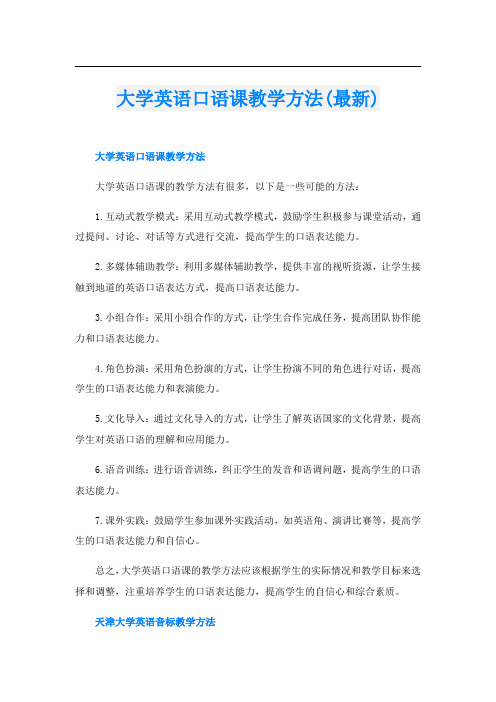
大学英语口语课教学方法(最新)大学英语口语课教学方法大学英语口语课的教学方法有很多,以下是一些可能的方法:1.互动式教学模式:采用互动式教学模式,鼓励学生积极参与课堂活动,通过提问、讨论、对话等方式进行交流,提高学生的口语表达能力。
2.多媒体辅助教学:利用多媒体辅助教学,提供丰富的视听资源,让学生接触到地道的英语口语表达方式,提高口语表达能力。
3.小组合作:采用小组合作的方式,让学生合作完成任务,提高团队协作能力和口语表达能力。
4.角色扮演:采用角色扮演的方式,让学生扮演不同的角色进行对话,提高学生的口语表达能力和表演能力。
5.文化导入:通过文化导入的方式,让学生了解英语国家的文化背景,提高学生对英语口语的理解和应用能力。
6.语音训练:进行语音训练,纠正学生的发音和语调问题,提高学生的口语表达能力。
7.课外实践:鼓励学生参加课外实践活动,如英语角、演讲比赛等,提高学生的口语表达能力和自信心。
总之,大学英语口语课的教学方法应该根据学生的实际情况和教学目标来选择和调整,注重培养学生的口语表达能力,提高学生的自信心和综合素质。
天津大学英语音标教学方法天津大学英语音标的教学可以采用以下方法:1.讲解发音器官和发音原理:通过图片和模型展示口腔内部结构,让学生了解发音器官的构造和发音原理。
2.示范发音:教师亲自发音,让学生观察口型、舌位和发音动作,模仿发音。
3.讲解音标发音特点:教师介绍每个音标的发音特点,包括送气与否、清浊音、口型和舌位等。
4.练习发音:教师播放录音,让学生跟读练习,逐渐掌握每个音标的发音。
5.纠正发音:教师逐个检查学生的发音,纠正错误,强化正确发音。
6.练习拼读:教师提供单词和短语,让学生练习拼读,掌握音标的正确拼读方式。
7.互动教学:教师组织小组讨论、角色扮演等活动,让学生在互动中巩固所学音标,提高口语表达能力。
8.评估学习成果:教师定期进行口语测试或课堂表现评估,了解学生的学习成果和进步情况,及时调整教学策略。
大学英语教学中的整体语言教学法

选 频 网
络
GND 路
到
近 几 十 , 流 行 的 英 语 教 学 模 式 珲 论 和 “ 体 语 法 ” 中来
相 吻 合 一 如 : o n s 和 Sne 的 多 层 次 理 论 、 t g 和 H he i r g Cuh ) Lbr 、a u l的 信 息 处 理 阅 读 理 论 、 远 方 和 R m l r a eg S m e e s 李 u e at h
的 相 互 作 用 心 理 语 言 理 论 、 te sn、u zr和 Gad e Mah w o L ne rn r的 情
图 2 数 据 收 发 部 分 结 构
3 通 讯 协 议
绪 型 阅 渎 理 论 、 建 新 和 V n D j、 i sh的 语 篇 层 次 j分 a i k K n e t : 析 阅 读 过 程 的理 论 。
删试节点的确认后继 续查询下一 节点:
住 阅 读 『 就 不 形 成 理 解 上 『 1
的障 碍 。 因 为 听 力 词 汇 要 小 于 阅 渎 渊 汇 量 , 读 词 汇 量 阅 能 覆 盖 听 力 词 汇 量 信息 处 理 阅 读 理 论 也 符 合 这 一 结 论 , 其 主 要 代 表 C u h 线 型 模 式 和 L b re与 S m e og 的 ae g a u l 信 息 自动 处 理 模 s的 式 , 信 息 处 理 的 角 度探 讨 了阅 渎过 程 . o g 从 .C u h的 线 型模 式
样就 避 免 r因 某 个 测 试 节 点 的 故 障 而 造 成 整 个 网 络 的 瘫
痪
阅 读 过 程 的 每 一 步 , 录 了 每 一 步 昕 需 要 的 时 间 他 的 研 记
大学英语教案备课技巧

大学英语教案备课技巧大学英语教学备课是一项颇为艰苦的任务,因为学生的英语水平较高,传统的教学方法已经无法满足他们的需求。
教师必须在备课中运用各种技巧,以便更好地引导学生学习英语。
以下几点是大学英语备课技巧,希望能够帮助到英语教学工作者。
一、制定教学目标无论是上课还是备课,始终要牢记一个目标:指导学生提高英语水平。
要实现这一目标,我们必须清晰地知道每堂课的目标,以及这些目标如何贯穿每个学期。
定量的、可衡量的目标将帮助教师确保学生完成了他们的任务,同时也提供了准确的反馈信息。
我们可以在教学计划中确立目标,清楚地进行授课。
通过学期中定期的考试和其他测评方式来评估学生在课程学习中的进步情况。
制定教学目标是成功教学的第一步,可以帮助教师成为更有组织的、更有针对性的教育者。
二、采用现代化教学方法许多传统的英语备课方法已经过时。
在现代化教育措施的推动下,教学方法也在不断变化。
教师应采用最新的、最适合当代学生的教学方法。
例如,多媒体教学可以通过PPT、视频、音频等形式,将知识传递给学生,让英语变成一种生动、有趣的体验。
更多的互动可以让学生更加积极地参与英语学习。
在备课时还可以运用现代化软件,进行教学设计。
三、在教学中使用真实例子对于大学英语教学来说,实际例子有着重要的意义。
这也是为什么教师在教学备课中必须寻找并使用最新、最准确的实例来说明英语概念的原因。
英语例子可以是来自新闻或其他来源的故事,销售报告或声音剪辑。
真实例子给学生展示了英语如何应用于实际的工作或生活场景当中,可以提高学习兴趣和参与度。
这也是英语备课中的一个重要任务,因为它能够为学生成为熟练的英语使用者提供相关的语境帮助。
四、备课前的检测备课的准备工作不仅涉及到教学大纲、资料和练习,还包括评估自己的知识水平。
在备课之前,应该对教学的英语主题和问题进行检验,确保掌握深度。
这意味着使用能够检验自己知识水平的测验,以确保自己是在有效地准备教学。
例如,你可以处理难度逐渐增加的单词表或句子练习,检验自己掌握知识深度。
大学英语听力教学

大学英语听力教学大学英语听力教学,全面解析,大学英语听力的传授方法。
下面是店铺给大家整理的大学英语听力教学,供大家参阅!大学英语听力教学方法长期以来,大学英语听力教学模式都是以教师为中心,教师的“一言课堂”的传统教学模式。
在这样的教学模式中,教师成为教学的主体,学生基本处于被动状态,师生之间缺乏感情沟通和知识信息的交流,课堂气氛枯燥,学生的主动性没有得到应有发挥,致使教与学在很到程度上脱离。
随着外语教学改革的日新月异,外语教育界都在探求日趋合理科学的教学模式,教学中日益注重以学生为主体和中心的教学模式,强调学生主动性发挥,和师生互动合作的交互性课堂。
基于交互式教学法的大学英语教学模式被越来越多的教师所推行并革新,对于现代外语教学起着非常重要的影响。
1交互式教学法概说交互式教学法又称互动教学法,最早是由Palinscar于1982年提出的,是一种适应时代的教学理论和策略。
区别于传统教学法中以教师为中心,学生被动参与学习的模式,交互式教学法则是以学生为中心,积极主动地参与组织教学的各个环节,让学生参与教学活动的全过程,真正成为教学活动的主体,与此同时还要注意发挥教师在教学中的主导作用,实现教师与学生、学生与学生的双向交流与互动。
简言之,它是旨在建立以教师为主导,以学生为主体,在师生、生生,以及人与多媒体之间通过“互动”方式组织起来的一套英语教学法。
“互动”是两个或更多的人相互交流思想感情,传递信息并产生相互影响的过程。
目前流行的交际英语教学理论的核心就是交际能力培养必须具备“互动”这个性质。
交际能力培养强调“互动”的重要性,是因为人类在各种背景下使用语言的目的就是“传递”信息,简单地说,是把自己头脑中的信息传递给另一人,反之亦然。
2交互式大学英语听力教学模式实施的必要性2.1大学英语听力教学的现状在目前的听力教学中,课堂的教学模式依然没有摆脱传统教学法的影响,听力课堂始终是气氛沉闷,形式呆板。
教师坐在语音室前面机械地播放录音,简单地提几个问题,或是根据教材按部就班地回答书本题目,是为上听力课而练习听力,课程的程式化冲淡了语言的实际交际功能;而有些教师也播放一些英文电影,只是让学生观看,没有做任何的听力理解的教学要求。
斯坦福大学外语课程五部教学法

斯坦福大学外语课程五部教学法关键字:教育 | 时间:2015/10/14 11:30:00英语五步教学法简介12英语五步教学法简介一般说来,除了第一节课以外,每一节课教师所要进行教学的内容不外乎三部分:1、复习已教过的语言材料;2、教学新的语言项目如词汇、语音、语法或句型等;3、进行各种形式的听、说、读、写训练活动。
为教学上述三部分内容,一般采用以下五个步骤(即五步教学法):步骤1 (Step 1): 复习 (Revision)步骤2 (Step 2): 介绍 (Presentation)步骤3 (Step 3): 操练 (Drill)步骤4 (Step 4): 练习 (Practice)步骤5 (Step 5): 巩固 (Consolidation)在每一个步骤当中,教师的作用都有所不同。
一位成功的教师一定是一位“多面手”,不但会讲解、还会指挥、会导演、会组织、会表演、会监督、会评判、会记分、会帮忙、会引导,而且还是一位很好的帮助学生强化记忆的人。
教师在课堂上能够扮演上述各种角色,就能够顺利地上好一节课,完成一节课的整体教学任务。
教师在各个步骤中的作用,请看下表:步骤(Steps) 教师的作用(Teacher’s Role/Job)复习 (Revision) 强化记忆者 (Memory activator)介绍 (Presentation) 示范表演者 (Demonstrator)操练 (Drills) 组织者/指挥者 (Organizer/Conductor)练习 (Practice) 裁判员/监督者/监听者(Referee/Supervisor/Listener)巩固 (Consolidation) 帮手(后来是记分员)(Helper, and later on, marker)教师在进行上述五个步骤的教学中,自始至终观察全班学生的反应,保证所教的内容大家都能理解。
如果相当一部分学生还没有弄懂,那么教师就需要重教。
大学英语教案教学方法
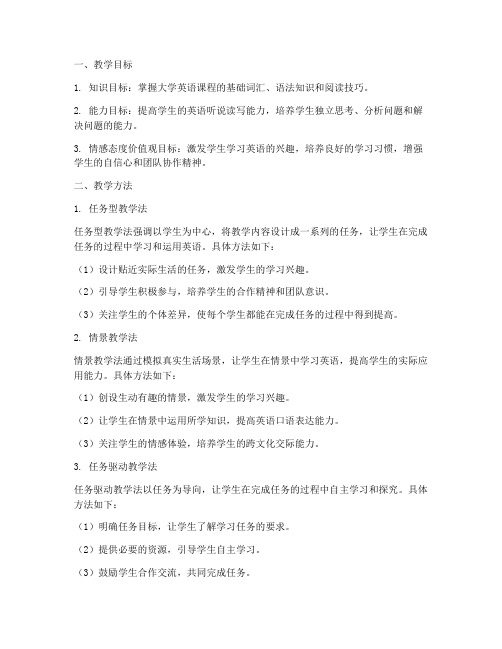
一、教学目标1. 知识目标:掌握大学英语课程的基础词汇、语法知识和阅读技巧。
2. 能力目标:提高学生的英语听说读写能力,培养学生独立思考、分析问题和解决问题的能力。
3. 情感态度价值观目标:激发学生学习英语的兴趣,培养良好的学习习惯,增强学生的自信心和团队协作精神。
二、教学方法1. 任务型教学法任务型教学法强调以学生为中心,将教学内容设计成一系列的任务,让学生在完成任务的过程中学习和运用英语。
具体方法如下:(1)设计贴近实际生活的任务,激发学生的学习兴趣。
(2)引导学生积极参与,培养学生的合作精神和团队意识。
(3)关注学生的个体差异,使每个学生都能在完成任务的过程中得到提高。
2. 情景教学法情景教学法通过模拟真实生活场景,让学生在情景中学习英语,提高学生的实际应用能力。
具体方法如下:(1)创设生动有趣的情景,激发学生的学习兴趣。
(2)让学生在情景中运用所学知识,提高英语口语表达能力。
(3)关注学生的情感体验,培养学生的跨文化交际能力。
3. 任务驱动教学法任务驱动教学法以任务为导向,让学生在完成任务的过程中自主学习和探究。
具体方法如下:(1)明确任务目标,让学生了解学习任务的要求。
(2)提供必要的资源,引导学生自主学习。
(3)鼓励学生合作交流,共同完成任务。
4. 交际教学法交际教学法强调在真实的语言环境中进行交流,提高学生的英语实际运用能力。
具体方法如下:(1)设计丰富多样的交际活动,让学生在活动中提高英语口语和听力水平。
(2)鼓励学生大胆开口,培养学生的自信心。
(3)关注学生的个体差异,尊重学生的个性化表达。
5. 翻转课堂教学法翻转课堂教学法将传统的教学方式颠倒过来,让学生在课前通过视频、音频等资源自主学习,课堂上教师进行辅导和答疑。
具体方法如下:(1)制作优质的课前学习资源,提高学生的学习效率。
(2)课堂上注重学生互动,培养学生的自主学习能力。
(3)关注学生的学习进度,及时调整教学策略。
6. 技术辅助教学法技术辅助教学法利用现代信息技术手段,提高英语教学质量。
大学英语教学方法总结
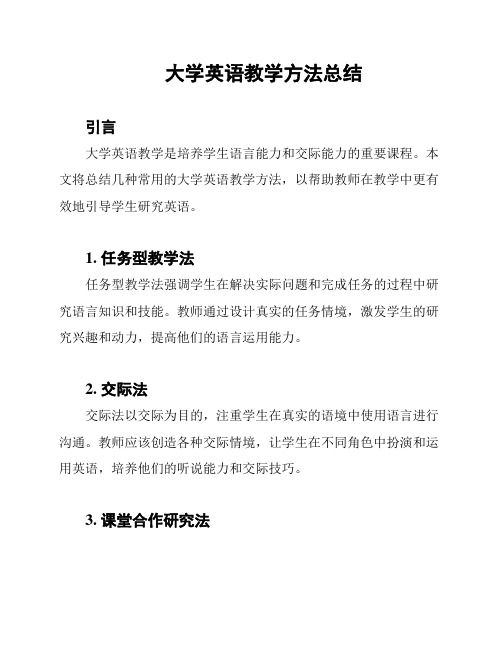
大学英语教学方法总结
引言
大学英语教学是培养学生语言能力和交际能力的重要课程。
本文将总结几种常用的大学英语教学方法,以帮助教师在教学中更有效地引导学生研究英语。
1. 任务型教学法
任务型教学法强调学生在解决实际问题和完成任务的过程中研究语言知识和技能。
教师通过设计真实的任务情境,激发学生的研究兴趣和动力,提高他们的语言运用能力。
2. 交际法
交际法以交际为目的,注重学生在真实的语境中使用语言进行沟通。
教师应该创造各种交际情境,让学生在不同角色中扮演和运用英语,培养他们的听说能力和交际技巧。
3. 课堂合作研究法
课堂合作研究法强调学生之间的合作与互动。
教师可以设计各种合作活动,鼓励学生之间的团队合作、互相研究和交流,提高他们的互助意识和语言能力。
4. 多媒体教学法
多媒体教学法利用现代技术手段,如投影仪、电脑等,辅助教学。
教师可以通过播放英语视频、使用教育软件等方式,提供丰富的研究资源,激发学生的研究兴趣和互动性。
5. 情景教学法
情景教学法通过创造真实的语境和情景,提供语言输入和输出的机会。
教师可以设计各种情景,让学生在实际情境中感受和运用英语,加强他们的语感和语言运用能力。
结论
不同的教学方法各有特点,教师可以根据学生的需求和教学目标选择合适的教学方法。
在教学过程中,教师还应注重激发学生的学习兴趣,鼓励学生的参与和合作,提高他们的语言能力和交际能力。
通过不断探索和创新,我们可以更好地提高大学英语教学的质量和效果。
大学英语教材教法教案

课程名称:大学英语授课对象:大一新生教学目标:1. 理解大学英语教材教法的原则和策略。
2. 掌握《全新大学英语》教材的特点和教学方法。
3. 提高学生的英语听说读写能力。
4. 培养学生的自主学习能力和跨文化交际意识。
教学内容:1. 大学英语教材教法概述2. 《全新大学英语》教材特点3. 教学方法与策略4. 教学案例分析与讨论教学过程:一、导入(5分钟)1. 教师简要介绍大学英语教材教法的重要性。
2. 引导学生思考如何提高英语学习效果。
二、大学英语教材教法概述(10分钟)1. 介绍大学英语教材教法的基本原则,如:任务型教学、交际法、合作学习等。
2. 分析教材教法的适用性,强调教材与教学方法的有机结合。
三、《全新大学英语》教材特点(10分钟)1. 介绍《全新大学英语》教材的编写背景和目标读者。
2. 分析教材内容,包括课文、词汇、语法、练习等。
3. 强调教材的实用性和趣味性。
四、教学方法与策略(15分钟)1. 介绍多种教学方法,如:情境教学法、任务型教学法、交际教学法等。
2. 分析不同教学方法的适用场景和实施步骤。
3. 提出具体的教学策略,如:小组合作、角色扮演、讨论等。
五、教学案例分析与讨论(20分钟)1. 教师提供《全新大学英语》教材中的教学案例。
2. 学生分组讨论,分析案例中采用的教学方法和策略。
3. 各组分享讨论成果,教师点评并总结。
六、总结与反思(5分钟)1. 教师总结本节课的主要内容,强调教材教法的重要性。
2. 引导学生反思自己的学习方法和效果,提出改进措施。
教学评价:1. 学生对大学英语教材教法的理解和掌握程度。
2. 学生在课堂活动中的参与度和表现。
3. 学生英语听说读写能力的提高情况。
教学资源:1. 《全新大学英语》教材及相关教学资料。
2. 多媒体教学设备,如:投影仪、电脑等。
3. 网络资源,如:在线英语学习平台、英语学习网站等。
课后作业:1. 阅读教材相关课文,完成课后练习。
2. 观看英语电影或视频,提高听力水平。
教学有法,教无定法——大学英语分级、分层教学总结

备教学 与学 员信息 素养 培养有 效结 合起来 ,探讨 装备 教学 的新模 能在今后的工作岗位上利用 自身素质迅速掌握信息化武器装备, 通 式 、新 路子 ,在实 践 中 强化 学 员 的信 息 素养 培 养 。首 先 ,以一 过 自身的不懈 努力达 到人装合 一的境 界 , 限度的发挥信 息化武 最大 部 具体信息 化装备 的教学为基 础 , 在横 向上可 以介 绍类型 相同但 技 器 装 备 的效 能 。 术不 同或 原理不 同 的相关 装备 ,使 学员 拓宽 知识 面 、扩展 视野 ; 人 才是 兴军 之本 , 战斗力 生成 之源 , 提高我 军信 息化条 是 是 在纵 向上介绍 装 备的研 革历 程 ,核心 技术 的发 展及 趋势 , 深 学 件下 实战能力 的根本保 证 。 院校必须 把培养适 应信息 化战争要 加 军事 员 对装 备 的理 解 。其 次 ,就一部 装备 具体 教学 而言 ,如何安 排 理 求 的新 型军事 人才作 为院校教 育的根本 目标 , 立信息时代 的人才 确 论 课程与实 践课程 的比例 , 安排一部装 备不 同系统 的教学 比例 培养 目标和能 力素质标 准 , 才培养模 式上敢 于创新 、 断摸索 , 如何 在人 不 都 是值得 深入 研究 的问题 。这需 要在 实践 中不 断积 累经验 、创新 更好地 为未来 的信 息 战争 进行人才储备 。 化 探 索 ,从 而确定 装备 教学 中 的黄 金分 割 。第 三 ,为强化 学员 理论 与 实 际 的 紧密结 合 ,可将 装 备 “ 人 ”课 堂 。例 如 :制作 优 秀 请 的多媒体装 备教学课件 , 使学员通 过虚拟操 作在课 堂上直 观了解装 备 。还可 将 较小 的系统 、分 机 、插 件 带入 课 堂 ,甚 至 在 条件 允
定差 异 。生缘部 分 是普通 高 中毕业部 分是 中专 艺术学 校毕 业 。普 高 职 艺 校 大 学 英 语 教 学 的 现 状 授课方式 1、困 境 ’ 通高 中跟 中专 艺术学校 在英语 教学上 的重视程度 不一样 , 高职艺校大学英语 教学的 目的是: “ 培养学生 的英语综合应用 能 有很 大 的差 异 。 比如, 的地方从 小学 就开设 了英语课 程, 的地方 有 有 力, 特别是听说能力, 使他们在今后工作和社 会交往 中能用英 语有效 地 则从 中学才开 始正 规的英 语教 育等 等 。又 比如 ,中专 艺术学 校 比
大学英语课堂中互动式教学法的应用

大学英语课堂中互动式教学法的应用摘要本文主要探讨了大学英语课堂中互动式教学法的应用。
互动式教学法是一种富有活力的课程教学方法,它能够激发学生的学习兴趣,促进学生的交流和思考能力。
在大学英语课堂教学中,互动式教学法也是一种非常有效的教学方法。
本文将介绍互动式教学法的定义、特点、实施方法以及在大学英语课堂中的应用,旨在为大学英语教学提供新的思路和方法。
1. 互动式教学法的定义与特点互动式教学法是一种以学生为主体、师生互动为特征的课程教学模式。
这种教学法通过多种方式,如小组讨论、角色扮演、竞赛游戏等,使学生积极参与、自主学习,从而达到提高学生思维和创造力、促进学生交流合作能力的目的。
互动式教学法的特点主要包括:•师生互动:教师和学生之间的对话交流是互动式教学法的主要形式,学生根据自己的学习经历和特点积极参与课堂活动,并与教师进行交流和讨论。
•多元化的学习形式:互动式教学法采用多种学习方式,包括小组合作、角色扮演、案例研究等,这些多元化的学习形式可以激发学生的学习兴趣,提高学习效果。
•追求目的:教师在进行互动式教学时,总是以学生的学习目标和需求为出发点,选取适合的学习方式和教育内容,以帮助学生顺利完成学业。
2. 互动式教学法在大学英语课堂中的实施方法在大学英语课堂中,互动式教学法具有很高的适用性,在实际教学中的实施方法包括以下几个方面:2.1 针对性教学方案教师需要在课程开设前,对学生了解其英语能力、学习意向等因素进行分析,以制定出适合学生的英语教学方案。
在课程的实施过程中,教师需要时刻考虑学生的学习需求,鼓励学生积极参与课堂讨论和互动。
2.2 设计开放式课堂互动式教学法的一个关键点是打破传统教学模式,让学生在自己的能力和兴趣的范围内进行学习和思考。
设计一个开放式的课堂,鼓励学生以自己的创新思维探究和分析语言知识,是互动式教学法实施成功的关键之一。
2.3 实现随时在线随时在线是互动式教学法实施的另一个关键。
读、听、写、说大学英语教学法

读、听、写、说大学英语教学法作者:郭晓春来源:《教师·理论研究》2008年第11期摘要:大学英语教学在我国已有上百年的历史,从最初的语法教学,到后来的听说教学法,再到现在多媒体技术的广泛使用,大学英语的教学可以说发生了翻天覆地的变化。
本文认为,大学英语教学实行阅读优先,听、写、说跟上的模式,更有利于提高学生的综合应用能力。
关键词:大学英语;教学法;阅读优先一长期以来,影响我国大学英语教学的传统方法,主要概括为如下两类:一种是语法翻译教学法。
这是最早的一种教学法。
该方法自19世纪40年代起到20世纪40年代止,在世界范围内得到广泛的应用。
该方法强调:语法结构为教授外语的基础,认为学习外语首先是学习语法;通过学习语法理解、翻译外语,培养学生的逻辑思维能力;主张详细分析、熟记语法规则,再将句子和课文翻译成母语或目标语言,通过翻译练习巩固语法规则;注重阅读和写作,主要通过阅读课文来教授和熟记生词。
这种教学方法在20世纪90年代前的中国受到广泛的应用,从课材的编写到教师的课堂教授,无不体现语法翻译优先的方法。
这种教学方法最大优点是极大地培养了学生阅读和写作能力,使学生普遍具有较为扎实的基本功,不足之处则是学生的应用能力极差,特别是听说能力。
随着经济全球化,国际间的交往日益频繁,越来越需要具有较强交际能力的外语人才,语法翻译教学法逐渐不能适应形势的发展要求而逐渐边缘化,第二种教学法应运而生。
这种教学法称为听说法,该方法产生于20世纪50年代,强调“听说为主和听说领先”,以听和说为主要的教学方法和手段,主张“先听说,后读写;以听说为主、读书为辅”,认为口语训练是培养其他语言技能的必要基础。
在教学中,以句型为纲,着重听说训练,学生的主要活动包括模仿、记忆、重复、交谈等实践;其次才是阅读、写作和扩大词汇量。
外语被用作教学的媒介,课堂上不鼓励用母语。
该方法从20世纪60年代开始在欧美等国盛行,而在中国从20世纪90年代之后一直到现在这种方法仍然占统治地位。
- 1、下载文档前请自行甄别文档内容的完整性,平台不提供额外的编辑、内容补充、找答案等附加服务。
- 2、"仅部分预览"的文档,不可在线预览部分如存在完整性等问题,可反馈申请退款(可完整预览的文档不适用该条件!)。
- 3、如文档侵犯您的权益,请联系客服反馈,我们会尽快为您处理(人工客服工作时间:9:00-18:30)。
C o m m u n i c a t i v e L a n g u a g e T e a c h i n g Language Processing and Production (语言理解和表达)1. The knowledge involved in language processingIn conclusion, when trying to work out the meaning of a piece of language or trying to express your own meaning, you need to use all the three types of knowledge: the knowledge of language(语言知识----语法、词汇、句子), discourse knowledge (语篇知识), and background knowledge (背景知识).Differences Between Oral and Written Communication(1) Spoken language is simpler than written language. (2) Spoken language has the lighter lexical density. Lexical density refers to the number of content words per clause.(3) Written language tends to use nouns instead of verbs(4) Writing is context independent, whereas speech is more closely tied to its context.Some features of spoken language:^ contraction (缩写)^ hesitation (停顿)^ filler ?^ repetition^ self-correction^ restarted utterance(重新表达)^ demonstrative words (指示词 this one, over there, near the door)Definition to Communicative Language Teaching1) Classroom goals are focused on all of the components of communicative competence(form /function /appropriation) and not restricted to grammatical and linguistic competence.语篇教学: 如:----Your phone! ----I ’m having a bath.2) Form is not the primary framework(syllabus 教学大纲) for organizing and sequencing lessons. Function (使用) is the framework through which forms are taught.3) Accuracy is secondary to conveying a message. Fluency may take on more importance than accuracy. The ultimate criterion for communicative success is the actual transmission and receiving of intended meaning.4) In the communicative classroom, students ultimately have to use the language productively(speaking and writing ) and receptively(reading and listening ) in unrehearsed contexts. Nature of Communicative Activities :有没有信息的转换 1. Students must have a desire to communicate. The English Language Curriculum (英语课程标准)一、对英语教学目标的重新认识语言知识:forms/linguistic competence (单词、句子、语法)语言技能:listening/speaking/reading/writing情感态度:attitude/confidence学习策略/方法文化意识二、强调学生语言运用能力的培养1)语言学习应成为语言实践的过程2)英语课堂为学生提供体验3)鼓励学生用实际生活进行语言学习4)大量实践形成语感三、练习与任务型的课堂教学练习:是否掌握语言形式交际语言教学(Communicative Language Teaching ,即CLT )形成与70年代末、80年代初。
经过近20年的发展以逐渐发展成为一种为世界语言教学界所普遍认同的教学思想、教学方向。
它的理论主要来自社会语言学、心理语言学和乔姆斯基的转换生成法。
其核心是任务:是否成功完成任务(real-life task)四、对学生学习评价的多样化The three stages of teaching reading1.Pre-reading stage(1) the aims of the pre-reading stages are three-fold(a) arousing the students’ interest in the topic or type of text;(b) motivating students to read the text by proving a purpose for reading;(c) preparing the students for the content of the text.(2) what the teacher can do to get the students to predict the contents of the text?^ examine the accompanying visual information(diagrams, maps, photographs),^ reflect on the title or the topic,^ state what they have already know about the topic,^ state what they would like to know about the topic,^ write their own questions that they want the text to answer,^ answer the teacher’s general questions about the text type or topic(oral or written),^ brainstorm the topic in groups or whole class,^ guess the topic by looking at key words from the text(given, and if necessary taught,by the teacher).2.While-reading stage(1) it aims to help the reader understand the content and structure of the text, as well as the author’s purpose in writing in it.(2) we aims to train the main reading skills: skimming, scanning, reading for detail, drawing inferences about the author’s purpose and intension. The typical sort of activities to train such skills are:^ skim reading to get the gist of the text,^ locating specific information^ transferring information from the text to a diagram, table, form, map, graph or picture,^ taking notes on the main points, or on specific points of the text,^ drawing a diagram to show the text structure,^ answering factual questions on the text,^ answering inference questions on the text(reading between the lines)^ putting the events in the correct order,^ stating if statements given about the text are true or false,^ working out the meaning of the words and phrases in the text from the context,^ examine referents in the text and stating what they refer to,^ putting the paragraphs of a jumbled text back in the correct order,^ giving sections of a text appropriate headings,^ giving the text an appropriate title(also possibly a post-reading activity).3.Post-reading------强调对之前所学知识的一个综合运用(1) it has two aims: one is to consolidate or reflect on what has been read in the text; the other is to relate the text to the students’ own knowledge, interests, or views.(2) the kinds of post-reading activities that are usually employed are:^ oral discussion of the topic of the text,^ role-play a different situation from that of the text but using the same characters, or role-play the same situations as in the text but using different characters,^ writing a summary of the main content of the text,^ comment on the content of the text,^ retelling the story of the text,^ finishing the story(oral or writing), that means either predicting an ending or changing the ending to one of your own choice^ listening to or reading some supplementary materials about the topic.。
